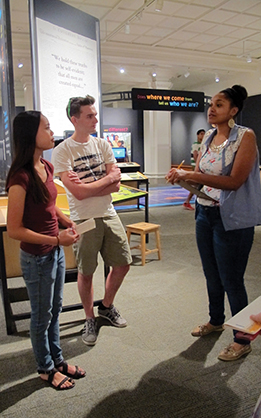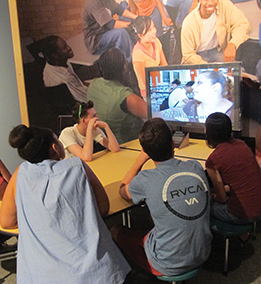 Fall 2014
Fall 2014|
“I am an African-American. My dad is 100% Kenyan and 100% awesome. My mom is a black-American and my hero!”
- Joan Mukogosi, a junior at Winchester Thurston |
Let's Talk About Race
How 20 high school students spent part of their summer doing what many adults probably wouldn’t dare—talk openly about race.On a large floor map of the world, 15-year-old Nova Fox plants her black sneakers on India. She’s petite but commanding of her audience of mostly peers, many of them strangers, gathered together inside RACE: Are We So Different?, an exhibition on view at Carnegie Museum of Natural History.
She looks across the Atlantic Ocean. “It’s just really cool,” she says with a pause, “to put it into perspective how far they actually went.” A sophomore at Lincoln Park Performing Arts Charter School in the Beaver County borough of Midland, Fox is one of 20 regional high school students who spent a chunk of their summer vacation helping to develop the museum’s Youth Summit on Race and Identity, an interactive program slated for October 22 that’s expected to draw dozens of area students and teachers. Museum educators initiated the idea of a program for teens by teens as a way to learn what’s important to young people about race and identity by getting them to talk to each other about it, something previous generations still haven’t mastered. RACE, a collaboration of the American Anthropological Association and the Science Museum of Minnesota, is billed as a conversation starter, and it’s gotten people talking, sharing, and educating each other in some 30 venues around the country. “Some people may lack the skills or the interest or the vocabulary or the courage to talk about race,” explains Cecile Shellman, communications specialist at the Museum of Natural History. “This exhibition really does invite people in overt and unconscious ways to talk about race.” Part of the museum’s challenge is to keep the conversation going long after the exhibition leaves Pittsburgh—and, ultimately, to affect measureable change in the community. Over the summer, with support from The Hive Fund for Connected Learning at The Sprout Fund, the museum teamed up with the YWCA of Greater Pittsburgh, The Labs at Carnegie Libraries of Pittsburgh, Literary Arts Boom (a creative writing lab for Pittsburgh youth), and sister museum The Andy Warhol Museum to host a series of workshops designed to empower teens to develop content for the October summit that, combined with the exhibition, will hopefully have ripple effects. The initial session gave the teens a chance to meet each other and consider some big ideas: what are the most important questions about race and identity for people your age; where do you think it’s most important to address racism; how and where do people learn racism; why a “race” exhibition; what influences your feelings and thoughts about racism; and, how can teens make a difference? “One of the big-picture goals of the summit is to engage a variety of different organizations in Pittsburgh that are doing this kind of work,” says Laurie Giarratani, assistant director of education at the Museum of Natural History. “The questions surrounding race are too big for the museum or the students to work through on their own.” In the spirit of the exhibition, the workshops have encouraged students to think outside of the box. To employ methods comfortable to them—such as art-making, writing, and performance—to explore difficult topics. “One of the explicit goals is to be putting resources in the hands of teens to see where they want to take this conversation next,” says Giarratani. For example, the group of students based at The Warhol and paired with Literary Arts Boom developed a visual guide to the exhibition in order to make its vastness less overwhelming. By using a fun, accessible format, such as trading cards or a 'zine (small, inexpensively made magazine) they want to share supplemental information relevant specifically to Pittsburgh teens, such as a list of regional scholarships available for youth of color listed alongside exhibition content focused on economics. Though a section of the exhibition is devoted to education, some students wondered out loud if RACE’s larger focus was on adult audiences, noting the exhibition’s very adult issues of money, housing, and illness. It’s a reminder, they say, that their voices are frequently not considered valuable—the exact oversight the workshops and the summit seek to correct. They did see themselves in the section of the show that highlights the Hapa Project, a multiracial identity art project created by American artist Kip Fulbeck. The Pittsburgh showing of RACE features 17 of the 1,200 minimalist portraits taken by the artist of individuals who self-identified as being of mixed ethnic heritage. After being photographed, participants chose their own terms to describe themselves, then responded to the question, “What are you?” in their own handwriting. The responses, some from children and teens, stopped many of the high schoolers in their tracks. Among their favorites: “My last boyfriend told me he liked me because of my race. So I dumped him.” The teens embraced the exercise. Joan Mukogosi, a 16-year-old junior at Winchester Thurston, wrote, “I am an African-American. My dad is 100% Kenyan and 100% awesome. My mom is a black-American and my hero!” Carrie Mannino, 15, wrote, “I’m a writer— mostly a poet. I celebrate Christmas and Hanukah because I’m ‘half and half.’ I check white but I wish there were more options. If anyone asks, I say I’m an artist.” Others identified themselves without mentioning race or ethnicity. Mollie March-Steinman, 17, a senior at Pittsburgh Creative and Performance Arts, sees herself as “a little too much. Too many opinions, too much talking, rambling, ranting, not enough doing or experiencing. I gotta step out of my comfort zone.” It’s telling to note that each of the 20 teens chose to do just that, voluntarily spending part of their summer at the museum talking openly about very personal topics. March-Steinman, a writer like Mannino, who identifies as “100% vanilla,” adds, “I see adults skirt around [the topic of race] a lot. It’s like, just chill, everyone’s affected by it.” She says being white doesn’t excuse her from the discussion. As head of her school’s Black Student Union, an afterschool club that frequently engages in discussions around race, Mukogosi says, “This just seems like the right place for me. I’m really excited to see how our work affects other students. Often in school, the people like us who are active don’t receive the amount of support that we want from our peers. Hopefully we can help other people care.”
|
Storyteller · Shock and Awe · Look Again · Thinking Like a Scientist · Director's Note · NewsWorthy · Face Time: Jo Ellen Parker · Artistic License: Out of the Vault · Science & Nature: The Body on Stage · Travel Log · The Big Picture
 |
Copyright © 2017 CARNEGIE Magazine. All rights reserved. |


